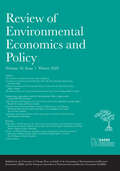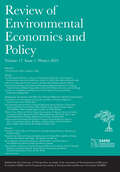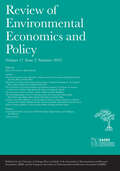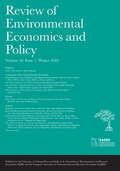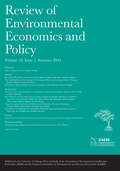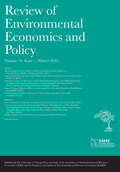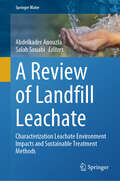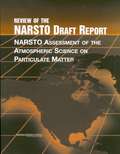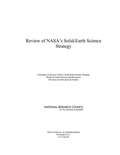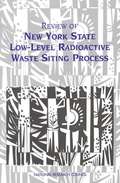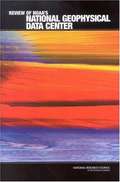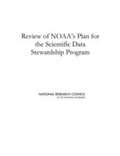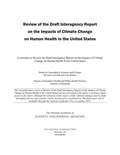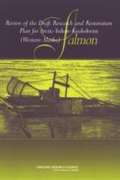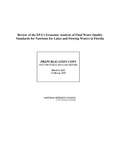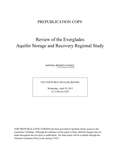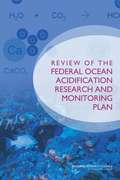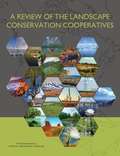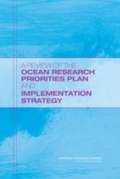- Table View
- List View
Review of Environmental Economics and Policy, volume 16 number 1 (Winter 2022)
by Review of Environmental Economics and PolicyThis is volume 16 issue 1 of Review of Environmental Economics and Policy. The Review of Environmental Economics and Policy (REEP) is an official journal of the Association of Environmental and Resource Economists and the European Association of Environmental and Resource Economists. REEP publishes symposia, articles, and regular features that contribute to one or more of the following goals: to identify and synthesize lessons learned from recent and ongoing environmental economics research; to provide economic analysis of environmental policy issues; to promote the sharing of ideas and perspectives among the various sub-fields of environmental economics; to strengthen the linkages between environmental economics research and environmental policy; to encourage communication and connections between academics and the wider policy community; to offer suggestions for future research; to provide insights and readings for use in the classroom; to address issues of interest to the environmental economics profession.
Review of Environmental Economics and Policy, volume 16 number 2 (Summer 2022)
by Review of Environmental Economics and PolicyThis is volume 16 issue 2 of Review of Environmental Economics and Policy. The Review of Environmental Economics and Policy (REEP) is an official journal of the Association of Environmental and Resource Economists and the European Association of Environmental and Resource Economists. REEP publishes symposia, articles, and regular features that contribute to one or more of the following goals: to identify and synthesize lessons learned from recent and ongoing environmental economics research; to provide economic analysis of environmental policy issues; to promote the sharing of ideas and perspectives among the various sub-fields of environmental economics; to strengthen the linkages between environmental economics research and environmental policy; to encourage communication and connections between academics and the wider policy community; to offer suggestions for future research; to provide insights and readings for use in the classroom; to address issues of interest to the environmental economics profession.
Review of Environmental Economics and Policy, volume 17 number 1 (Winter 2023)
by Review of Environmental Economics and PolicyThis is volume 17 issue 1 of Review of Environmental Economics and Policy. The Review of Environmental Economics and Policy (REEP) is an official journal of the Association of Environmental and Resource Economists and the European Association of Environmental and Resource Economists. REEP publishes symposia, articles, and regular features that contribute to one or more of the following goals: to identify and synthesize lessons learned from recent and ongoing environmental economics research; to provide economic analysis of environmental policy issues; to promote the sharing of ideas and perspectives among the various sub-fields of environmental economics; to strengthen the linkages between environmental economics research and environmental policy; to encourage communication and connections between academics and the wider policy community; to offer suggestions for future research; to provide insights and readings for use in the classroom; to address issues of interest to the environmental economics profession.
Review of Environmental Economics and Policy, volume 17 number 2 (Summer 2023)
by Review of Environmental Economics and PolicyThis is volume 17 issue 2 of Review of Environmental Economics and Policy. The Review of Environmental Economics and Policy (REEP) is an official journal of the Association of Environmental and Resource Economists and the European Association of Environmental and Resource Economists. REEP publishes symposia, articles, and regular features that contribute to one or more of the following goals: to identify and synthesize lessons learned from recent and ongoing environmental economics research; to provide economic analysis of environmental policy issues; to promote the sharing of ideas and perspectives among the various sub-fields of environmental economics; to strengthen the linkages between environmental economics research and environmental policy; to encourage communication and connections between academics and the wider policy community; to offer suggestions for future research; to provide insights and readings for use in the classroom; to address issues of interest to the environmental economics profession.
Review of Environmental Economics and Policy, volume 18 number 1 (Winter 2024)
by Review of Environmental Economics and PolicyThis is volume 18 issue 1 of Review of Environmental Economics and Policy. The Review of Environmental Economics and Policy (REEP) is an official journal of the Association of Environmental and Resource Economists and the European Association of Environmental and Resource Economists. REEP publishes symposia, articles, and regular features that contribute to one or more of the following goals: to identify and synthesize lessons learned from recent and ongoing environmental economics research; to provide economic analysis of environmental policy issues; to promote the sharing of ideas and perspectives among the various sub-fields of environmental economics; to strengthen the linkages between environmental economics research and environmental policy; to encourage communication and connections between academics and the wider policy community; to offer suggestions for future research; to provide insights and readings for use in the classroom; to address issues of interest to the environmental economics profession.
Review of Environmental Economics and Policy, volume 18 number 2 (Summer 2024)
by Review of Environmental Economics and PolicyThis is volume 18 issue 2 of Review of Environmental Economics and Policy. The Review of Environmental Economics and Policy (REEP) is an official journal of the Association of Environmental and Resource Economists and the European Association of Environmental and Resource Economists. REEP publishes symposia, articles, and regular features that contribute to one or more of the following goals: to identify and synthesize lessons learned from recent and ongoing environmental economics research; to provide economic analysis of environmental policy issues; to promote the sharing of ideas and perspectives among the various sub-fields of environmental economics; to strengthen the linkages between environmental economics research and environmental policy; to encourage communication and connections between academics and the wider policy community; to offer suggestions for future research; to provide insights and readings for use in the classroom; to address issues of interest to the environmental economics profession.
Review of Environmental Economics and Policy, volume 19 number 1 (Winter 2025)
by Review of Environmental Economics and PolicyThis is volume 19 issue 1 of Review of Environmental Economics and Policy. The Review of Environmental Economics and Policy (REEP) is an official journal of the Association of Environmental and Resource Economists and the European Association of Environmental and Resource Economists. REEP publishes symposia, articles, and regular features that contribute to one or more of the following goals: to identify and synthesize lessons learned from recent and ongoing environmental economics research; to provide economic analysis of environmental policy issues; to promote the sharing of ideas and perspectives among the various sub-fields of environmental economics; to strengthen the linkages between environmental economics research and environmental policy; to encourage communication and connections between academics and the wider policy community; to offer suggestions for future research; to provide insights and readings for use in the classroom; to address issues of interest to the environmental economics profession.
Review Of The Gapp Science And Implementation Plan
by National Research Council of the National AcademiesWater managers rely on predicting changes in the hydrologic cycle on seasonal-to-interannual time frames to prepare for water resource needs. Seasonal to interannual predictability of the hydrologic cycle is related to local and remote influences involving land processes and ocean processes, such as the El Niño Southern Oscillation. Although advances in understanding land-surface processes show promise in improving climate prediction, incorporating this information into water management decision processes remains a challenge since current models provide only limited information for predictions on seasonal and longer time scales. To address these needs, the Global Energy and Water Cycle Experiment (GEWEX) Americas Prediction Project (GAPP) was established in 2001 to improve how changes in water resources are predicted on intraseasonal-to-interannual time scales for the continental United States. The GAPP program has developed a science and implementation plan to guide its science activities, which describes strategies for improving prediction and decision support in the hydrologic sciences. This report by the National Research Council provides a review of the GAPP Science and Implementation Plan, outlining suggestions to strengthen the plan and the GAPP program overall.
A Review of Landfill Leachate: Characterization Leachate Environment Impacts and Sustainable Treatment Methods (Springer Water)
by Salah Souabi Abdelkader AnouzlaSolid waste landfilling and related environmental issues have become global concerns, particularly in developing countries. Accelerating population growth and changing lifestyles have exacerbated health and environmental challenges. This book looks at the global ramifications of leachate characterization and environmental impacts, highlighting the different issues related to landfilling, such as leachate generation and its constituents. When water enters a landfill, it assimilates the dissolved components of the decomposing waste, thus forming a leachate with considerable impacts on the environment. The nature of the landfill and the waste received (household waste alone or mixed with industrial waste) determine whether the leachate produced is hazardous or not. The decomposition of solid waste in landfills goes through several stages, including an initial aerobic phase, an anaerobic acid phase, an initial methanogenic phase and a stable methanogenic phase. Leachates can contain significant concentrations of heavy metals, inorganic salts, ammonia, halogenated hydrocarbons, suspended matter, organic pollutants in significant quantities... Generally, leachate discharges are rich in phenol, highly toxic polluting ammonium. Ecotoxicological assessment of this effluent is essential to determine the impact of its contaminants on the aquatic ecosystem. If pollutants are not disposed of properly, leachate from landfills can potentially enter soils and subsoils, severely contaminating surface and groundwater bodies. Therefore, reducing pollutant levels through leachate treatment has garnered considerable attention in recent decades. This publication is an invaluable resource, providing up-to-date information on the impact and characterization of leachate landfills. It is therefore time to accentuate the training of executives with all the skills to facilitate the waste management through the research efforts of academics, in the field of solid wastelandfill operations.
Review Of The Narsto Draft Report: Narsto Assessment Of The Atmospheric Science On Particulate Matter
by Committee to Review NARSTO's Scientific Assessment of Airborne Particulate MatterThe report reviews NARSTO's recent report on atmospheric science issues associated with management of airborne particulate matter (PM) to achieve air quality standards. NARSTO is a public-private partnership with members from government, utilities, industry, and academe in Canada, Mexico and the United States that coordinates ozone-related atmospheric science research and assessment.
Review of NASA's Solid-Earth Science Strategy
by Committee to Review NASA's Solid-Earth Science StrategyThe report reviews NASA's solid-earth science strategy, placing particular emphasis on observational strategies for measuring surface deformation, high-resolution topography, surface properties, and the variability of the earth's magnetic and gravity fields. The report found that NASA is uniquely positioned to implement these observational strategies and that a number of agency programs would benefit from the resulting data. In particular, the report strongly endorses the near-term launch of a satellite dedicated to L-band InSAR measurements of the land surface, which is a key component of the U. S. Geological Survey's hazards mitigation program and the multi-agency EarthScope program.
Review of New York State Low-Level Radioactive Waste Siting Process
by Committee to Review New York State's Siting Methodology Selection for Low-Level Radioactive Waste DisposalThis book reviews the efforts of New York state to site a low-level radioactive waste disposal facility. It evaluates the nature, sources, and quality of the data, analyses, and procedures used by the New York State Siting Commission in its decisionmaking process, which identified five potential sites for low-level waste disposal. Finally, the committee offers a chapter highlighting the lessons in siting low-level radioactive waste facilities that can be learned from New York State's experience.
Review Of Noaa's National Geophysical Data Center
by Committee to Review NOAA's National Geophysical Data CenterThe report reviews the National Geophysical Data Center (NGDC) and assesses how well the center is managing its holdings, serving its users, and supporting NOAA's mission. It concludes that NGDC is the natural place within NOAA and the nation for stewardship and dissemination of data related to the solid Earth and space environment. These subject areas are also relevant to NOAA’s new priority on integrated environmental approaches. For NGDC to fulfill its potential, however, it must first rearticulate its mission and overcome some solvable problems, including obtaining effective feedback from its users and organizing the center to eliminate parallel activities and reduce scientific isolation among the divisions.
Review of NOAA's Plan for the Scientific Data Stewardship Program
by National Research Council of the National AcademiesTo better understand our climate system, it is important that we have climate data records (CDRs)--time series of measurements of sufficient length, consistency, and continuity to determine climate variability and change--that possess the accuracy, longevity, and stability to facilitate credible climate monitoring. In 2004, the National Research Council (NRC) published Climate Data Records from Environmental Satellites to provide the National Oceanic and Atmospheric Administration (NOAA) with initial guidelines on how to develop and implement an effective CDR program. NOAA used this book to draft a plan for a new Scientific Data Stewardship (SDS) program, and then asked NRC to review it. The new program will be responsible for processing, archiving, and distributing observations from satellite and supporting ground-based platforms for monitoring, diagnosing, understanding, predicting, modeling, and assessing climate variation and change. The NRC review outlines several ways in which to improve NOAA's draft plan, most importantly by clarifying advisory mechanisms, providing more detail about how NOAA will coordinate with important partners in generating CDRs, articulating how the program will prioritize its activities, and developing ways to realistically project future costs. However, the draft plan is sound overall and NOAA should immediately begin implementing the SDS program while revising the plan as recommended in the book.
Review of Proposals to the Bureau of Land Management on Wild Horse and Burro Sterilization or Contraception: A Letter Report
by Committee for the Review of Proposals to the Bureau of Land Management on Wild Horse Burro Sterilization or ContraceptionAs a follow-up to the 2013 report Using Science to Improve the Wild Horse and Burro Program: A Way Forward, this letter report reviews research project proposals submitted to the Bureau of Land Management and aimed at developing new or refining existing techniques and establishing protocols for the contraception or permanent sterilization of either male or female wild horses and/or burros in the field. Review of Proposals to the Bureau of Land Management on Wild Horse and Burro Sterilization or Contraception considers factors related to the scientific validity of the proposed technique(s), goals and objectives of the work, research methodology and design of the study, proposed statistical analysis and interpretation of anticipated data obtained, animal welfare implications and Institutional Animal Care and Use Committee approvals, feasibility, as well as the qualifications, expertise, and experience of the investigators. This report ranks the proposals in order of merit and provides a brief report on additional factors for the Bureau of Land Management to consider in selecting proposals to fund.
Review of the Draft Interagency Report on the Impacts of Climate Change on Human Health in the United States
by National Academies of Science Engineering MedicineThe U.S. National Climate Assessment (NCA; Melillo et al., 2014) identified a number of ways in which climate change is affecting or is likely to affect, people, infrastructure, natural resources, and ecosystems. Those impacts in turn have the potential for important current and future consequences for human health. Research on these impacts is active, with strong evidence to support some aspects and research still in progress for others. Therefore, there is a need to assess our understanding of how the impacts of climate change on the environment can create stressors that can affect human health in a number of dimensions both now and in the future. <P> In response to this need, the U.S. Global Change Research Program (USGCRP) has initiated an interagency Assessment on the Impacts of Climate Change on Human Health in the United States. The Assessment is intended to inform public health authorities, other planning and policy entities, and the general public. It extends the work begun under the 2008 Synthesis and Assessment Product 4.6 (USGCRP, 2008) Analyses of the Effects of Global Change on Human Health and Welfare and Human Systems and the third NCA released in 2014.
Review of the Draft Plan for the Modernization and Associated Restructuring Demonstration
by National Weather Service Modernization CommitteeThe National Academies Press (NAP)--publisher for the National Academies--publishes more than 200 books a year offering the most authoritative views, definitive information, and groundbreaking recommendations on a wide range of topics in science, engineering, and health. Our books are unique in that they are authored by the nation's leading experts in every scientific field.
Review of the Draft Research and Restoration Plan for Arctic-Yukon-Kuskokwim (Western Alaska) Salmon
by National Research Council of the National AcademiesDeclines in the abundance of salmon in the Arctic-Yukon-Kuskokwim (AYK) region of western Alaska in the late 1990s and early 2000s created hardships for the people and communities who depend on this resource. Based on recommendations from a 2004 National Academies report, the AYK Sustainable Salmon Initiative (SSI) developed a research and restoration plan to help understand the reasons for this decline and to help support sustainable management in the region. This report reviews the draft plan, recommending some clarification, shortening, and other improvements, with a better focus on the relationship between the underlying intellectual model and the research questions, and a clearer discussion of local and traditional knowledge and capacity building.
Review of the EPA's Economic Analysis of Final Water Quality Standards for Lakes and Flowing Waters in Florida
by Committee to Review EPA's Economic Analysis of Final Water Quality Standards for Nutrients for Lakes Flowing Waters in FloridaThe Environmental Protection Agency's estimate of the costs associated with implementing numeric nutrient criteria in Florida's waterways was significantly lower than many stakeholders expected. This discrepancy was due, in part, to the fact that the Environmental Protection Agency's analysis considered only the incremental cost of reducing nutrients in waters it considered "newly impaired" as a result of the new criteria-not the total cost of improving water quality in Florida. The incremental approach is appropriate for this type of assessment, but the Environmental Protection Agency's cost analysis would have been more accurate if it better described the differences between the new numeric criteria rule and the narrative rule it would replace, and how the differences affect the costs of implementing nutrient reductions over time, instead of at a fixed time point. Such an analysis would have more accurately described which pollutant sources, for example municipal wastewater treatment plants or agricultural operations, would bear the costs over time under the different rules and would have better illuminated the uncertainties in making such cost estimates.
Review of the Everglades Aquifer Storage and Recovery Regional Study
by Committee to Review the Florida Aquifer Storage Recover Regional Study Technical Data ReportThe Florida Everglades is a large and diverse aquatic ecosystem that has been greatly altered over the past century by an extensive water control infrastructure designed to increase agricultural and urban economic productivity. The Comprehensive Everglades Restoration Plan (CERP), launched in 2000, is a joint effort led by the state and federal government to reverse the decline of the ecosystem. Increasing water storage is a critical component of the restoration, and the CERP included projects that would drill over 330 aquifer storage and recovery (ASR) wells to store up to 1. 65 billion gallons per day in porous and permeable units in the aquifer system during wet periods for recovery during seasonal or longer-term dry periods. To address uncertainties regarding regional effects of large-scale ASR implementation in the Everglades, the U. S. Army Corps of Engineers (USACE) and the South Florida Water Management District conducted an 11-year ASR Regional Study, with focus on the hydrogeology of the Floridan aquifer system, water quality changes during aquifer storage, possible ecological risks posed by recovered water, and the regional capacity for ASR implementation. At the request of the USACE, "Review of the Everglades Aquifer Storage and Recovery Regional Study" reviews the ASR Regional Study Technical Data Report and assesses progress in reducing uncertainties related to full-scale CERP ASR implementation. This report considers the validity of the data collection and interpretation methods; integration of studies; evaluation of scaling from pilot-to regional-scale application of ASR; and the adequacy and reliability of the study as a basis for future applications of ASR.
Review of the Federal Ocean Acidification Research and Monitoring Plan
by National Research Council Ocean Studies Board Committee on the Review of the National Ocean Acidification Research and Monitoring Plan Division on Earth and Life StudiesThe world's ocean has already experienced a 30% rise in acidity since the industrial revolution, with acidity expected to rise 100 to 150% over preindustrial levels by the end of this century. Potential consequences to marine life and also to economic activities that depend on a healthy marine ecosystem are difficult to assess and predict, but potentially devastating. To address this knowledge gap, Congress passed the Federal Ocean Acidification Research and Monitoring (FOARAM) Act in 2009, which, among other things, required that an interagency working group create a "Strategic Plan for Federal Research and Monitoring of Ocean Acidification." Review of the Federal Ocean Acidification Research and Monitoring Plan reviews the strategic plan on the basis of how well it fulfills program elements laid out in the FOARAM Act and follows the advice provided to the working group in the NRC's 2010 report, Ocean Acidification: A National Strategy to Meet the Challenges of a Changing Ocean. This report concludes that, overall, the plan is strong and provides a comprehensive framework for improving our understanding of ocean acidification. Potential improvements include a better defined strategy for implementing program goals, stronger integration of the seven broad scientific themes laid out in the FOARAM Act, and better mechanisms for coordination among federal agencies and with other U.S. and international efforts to address ocean acidification.
Review of the Lake Ontario-St. Lawrence River Studies
by National Research Council of the National AcademiesSince the 1950s,the International Joint Commission (IJC) of Canada and the United States has issued water regulation and management plans for Lake Ontario and the St. Lawrence River. Changes in recreational, environmental, navigational and other uses of the water system have prompted the IJC to consider replacing the current water regulation plan in operation for more than 40 years. IJC’s goals for a replacement plan include sound scientific foundations, public participation, transparency in plan development and evaluation, and inclusion of environmental considerations. To help develop and select the new plan, the IJC supported a 5-year, $20 million Lake Ontario-St. Lawrence River Study (LOSLR Study). The LOSLR Study uses models to compile and integrate data gathered from a series of commissioned studies of wetlands, species at risk, recreational boating, fisheries, coastal erosion and flooding, commercial navigation, hydropower, industrial, municipal and domestic water intakes, public information and education, and hydrologic modeling. This report reviews a portion of the study that focused on wetlands and species at risk and three of the models that were used. The report finds that the overall breadth of the LOSLR study is impressive, and commends the scale and inclusiveness of the studies and models. In terms of informing decision making, however, the reviewed studies and models show deficiencies when evaluated against ten evaluation criteria, including treatment of uncertainty, quality control/quality assurance, thorough documentation, and empirical foundations. Among the report’s recommendations is a need for more thorough documentation of study methods and findings, stronger and more consistent quality control, and more attention to how uncertainty should be addressed to better inform decision making. This NRC study was conducted in collaboration with the Royal Society of Canada.
A Review of the Landscape Conservation Cooperatives
by National Academies of Sciences Engineering MedicineThe United States' tradition of conserving fish, wildlife, habitats, and cultural resources dates to the mid-19th century. States have long sought to manage fish and wildlife species within their borders, whereas many early federal conservation efforts focused on setting aside specific places as parks, sanctuaries, or reserves. With advances in landscape ecology over the past quarter-century, conservation planners, scientists, and practitioners began to stress the importance of conservation efforts at the scale of landscapes and seascapes. These larger areas were thought to harbor relatively large numbers of species that are likely to maintain population viability and sustain ecological processes and natural disturbance regimes - often considered critical factors in conserving biodiversity. By focusing conservation efforts at the level of whole ecosystems and landscape, practitioners can better attempt to conserve the vast majority of species in a particular ecosystem. Successfully addressing the large-scale, interlinked problems associated with landscape degradation will necessitate a planning process that bridges different scientific disciplines and across sectors, as well as an understanding of complexity, uncertainty, and the local context of conservation work. The landscape approach aims to develop shared conservation priorities across jurisdictions and across many resources to create a single, collaborative conservation effort that can meet stakeholder needs. Conservation of habitats, species, ecosystem services, and cultural resources in the face of multiple stressors requires governance structures that can bridge the geographic and jurisdictional boundaries of the complex socio-ecological systems in which landscape-level conservation occurs. The Landscape Conservation Cooperatives (LCC) Network was established to complement and add value to the many ongoing state, tribal, federal, and nongovernmental efforts to address the challenge of conserving species, habitats, ecosystem services, and cultural resources in the face of large-scale and long-term threats, including climate change. A Review of the Landscape Conservation Cooperatives evaluates the purpose, goals, and scientific merits of the LCC program within the context of similar programs, and whether the program has resulted in measurable improvements in the health of fish, wildlife, and their habitats.
A Review Of The Ocean Research Priorities Plan And Implementation Strategy
by National Research Council of the National AcademiesOcean research offers countless benefits, from improving fisheries management to discovering new drugs to enabling early detection of tsunamis and hurricanes. At the request of the Joint Subcommittee on Ocean Science and Technology (JSOST), the National Research Council convened a committee to review the draft and final versions of the Ocean Research Priorities Plan and Implementation Strategy described in Charting the Course for Ocean Science in the United States: Research Priorities for the Next Decade, which represents the first coordinated national ocean research planning effort involving all federal agencies that support ocean science. The plan presents an ambitious vision for ocean research that will be of great benefit to the ocean sciences community and the nation. This book contains both sets of findings (i.e., the committee's review of the JSOST's draft plan [A Review of the Draft Ocean Research Priorities Plan: Charting the Course for Ocean Science in the United States] and the review of the final plan). This book recommends that JSOST employ a variety of outreach mechanisms to continue to engage nonfederal partners in ocean research planning efforts, such as establishing external committees to provide scientific and technical advice and to review progress on implementation of the research plan.
Review of the St. Johns River Water Supply Impact Study: Report 1
by National Research Council of the National AcademiesThe St. Johns River is the longest river in Florida, containing extensive freshwater wetlands, numerous large lakes, a wide estuarine channel, and a correspondingly diverse array of native flora and fauna. Water resource management in the river's watershed is the responsibility of the St. Johns River Water Management District (the District). The District must provide water for the region's 4.4 million residents as well as numerous industrial and agricultural users, all while protecting natural systems within the river basin. With population growth in the watershed expected to surpass 7.2 million in 2030, the District, through its water resources planning process, has begun to identify alternative sources of water beyond its traditional groundwater sources, including the potential withdrawal of 262 million gallons per day from the St. Johns River. To more comprehensively evaluate the environmental impacts of withdrawing this water from the river, the District embarked on a two-year Water Supply Impact Study (WSIS), and requested the involvement of the National Research Council. The present volume reviews the Phase I work of the WSIS and provides recommendations for improving Phase II.
